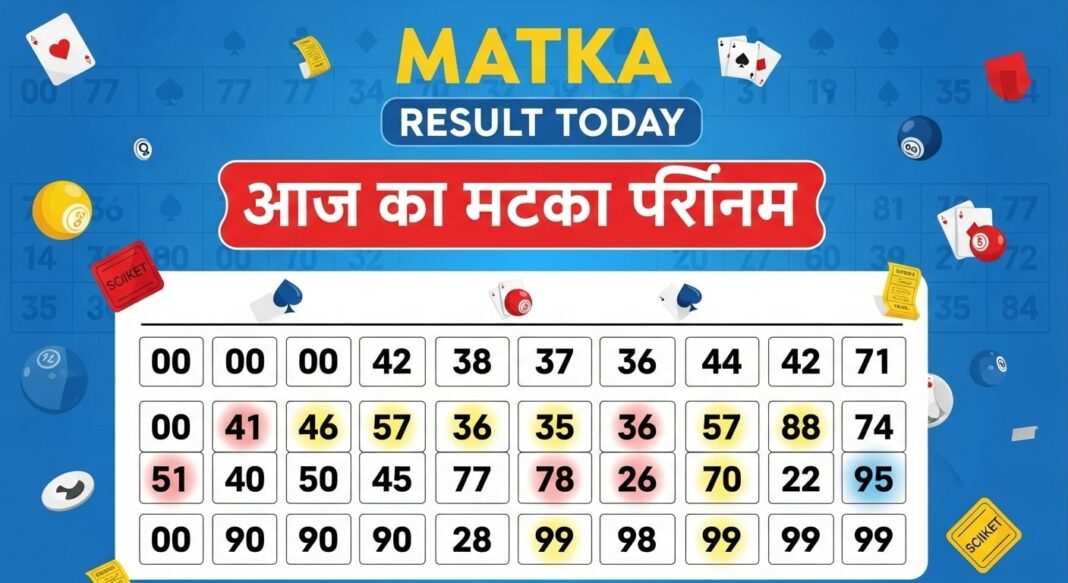In the world of underground number-based betting in India, the matka result comes up a lot. It may seem easy — it’s just a result – but there are a lot of layers of history, procedure, and risk that go into what it really means in practice.
What is the “matka result”?
In the context of the betting game commonly known as Satta Matka, the “matka result” refers to the declared outcome of a draw – typically involving numbers, and often divided into “Open” and “Close” results.
Historically, the term “matka” means an earthen pot from which slips or numbers were drawn to determine winners. So, the “matka result” is essentially the end‑point of a process that begins with bets and ends with specific numbers being announced.
Historical background
The origins of matka gaming and consequently the formation of the matka outcome, trace back several decades. People think that the contemporary form began in Mumbai in the early 1960s. One of the first versions was based on the open and closing prices of cotton sent from the New York Cotton Exchange to Mumbai and subsequently changed into a betting game. Over time, the game changed: sticks that stood for numbers were put into an earthen pot (matka), numbers were selected and winners were announced through what we now call the matka result.
This game and the announcement of the matka outcome have mostly happened outside of regulated systems because they are informal and subterranean.
How the matka result is generated and structured
The process to generate a matka result is loosely defined and may differ from one market to another – but there are patterns that are quite common:
- There may be an Open outcome, which is the initial draw of numbers.
- Then a Close result: a second draw or the second part of the draw.
- The result is generally shown as a three-digit number (“patti” or “panna”) along with single digits or pairs (“jodi”) that emerge from adding the numbers together.
Common terms in the matka result process
| Term | Meaning |
| Single / Ank | A single digit between 0‑9 on which a bet may be placed. |
| Jodi / Pair | Two‑digit number (00‑99) formed through game mechanics. |
| Patti / Panna | A three‑digit number result, often shown in the chart. |
| Open / Close | Open is the first half of the draw, Close is the second. |
| Farak | The difference between the Close result and Open result. |
Thus when someone refers to the “matka result” for a given market or session, they are referring to the specific numbers declared for that time.
Popular markets and result times
There are several separate markets (or “bazars”) in the Satta Matka universe, and each one has its own timetable and rules. For instance, the markets could be named by areas or times of day when they are open (like Day and Night sessions). At certain times for each market, the matka outcome will be announced. Some sources, for example, talk of morning, evening, or night rounds.
The exact time of the matka result has a big effect on the flow of the betting activities because these result times are very important to the people who are taking part.
Reading and interpreting the matka result
A person who gets or sees the matka result needs to know what the numbers mean. The notation can be different, but a common way to write it is like this: 135 – 90 – 389, where “135” could mean Open patti, “90” could mean the jodi, and “389” could mean Close patti.
Another element of reading is looking for patterns in past results (“record charts”). However, it should be noted that patterns in this game are essentially fake because the number draws are random or almost random.
Risks, legality and social implications
When one discusses the matka result, it’s important to highlight the major risks and the legal realities:
- Legality: The Public Gambling Act and other state legislation make Satta Matka illegal in most of India.
- Highly speculative: The odds of winning are very low; some sources say they are less than 1% for profitable results.
- Exploitation: Since there are no rules, people who take part could be scammed, have the outcome changed, or not get paid what they think they won.
- Addiction and social harm: People who are waiting for the matka outcome and hoping to get rich may do things that are dangerous, go into debt and feel bad.
- False promise of strategies: Many websites or people say they have “guesses” or “tips” about what the next matka outcome will be, but the result is designed to be random. It’s usually not smart to invest in a method that you think will work.
Thus, while the lure of the matka result (and large payouts) may be attractive, the underlying odds and legal context make it quite a precarious endeavour.
Why the matka result remains so central
For many players, the moment the numbers are declared – i.e. the matka result – is the climax of the game. It is the point at which the bet is resolved. Because of that, the result holds significant psychological weight: hope builds until the moment of reveal.
Also, because the result is publicly visible (via charts or online portals), it creates a social dynamic of comparison: players check their tickets, compare past results, discuss “trends.” Even though trends may not reliably predict future results, the spectacle around the matka result keeps the game alive.
Lastly, the simplicity of understanding what the matka result is (just numbers) allows for easy participation – which is one reason the game spread despite legal and moral concerns.
Final thoughts
While the matka result might sound innocuous, the full context behind it reveals a complex environment of number games, risk, chance and legal ambiguity. It’s quite likely that many participants view the result simply as the pay‑out moment, but for each successful outcome there are many who lose money, or worse, become entangled in more serious problems.
Most experts would caution that relying on the matka result as a means of earning rather than betting should be approached with extreme scepticism. In order to engage with this world (or to understand it from outside), one must be aware of the history, the structure of the games, the way result formats are published and the inherent risks involved.
Ultimately, the matka result remains at the heart of one of India’s most enduring and controversial number‑betting traditions – a tradition that continues largely in the shadows. If one is to observe it or participate (not recommended from a legal and moral standpoint), awareness of the mechanics and implications is key.
Frequently Asked Questions (FAQs)
Q1: What exactly does “matka result” include?
A: Usually it includes the Open number (or numbers), the Close number, and derived values such as Jodi or Patti. The result is the formal declaration of what has been drawn, and determines which bets win.
Q2: Can one trust the websites that publish matka result charts?
A: Because the entire activity is mostly unregulated, trust is a big issue. Some websites may publish results quickly, but verifying fairness or authenticity is quite difficult.
Q3: How often is the matka result declared?
A: It varies based on the specific market (bazaar). Some markets have daily draws, others six days a week; the times differ by morning, day or night sessions.
Q4: Is there a fool‑proof strategy to “guess” the next matka result?
A: No. Though many claim systems or charts, the result is meant to be random and there is no guaranteed strategy to predict the next outcome. Most players lose over time.
Q5: Is participating in matka and relying on the matka result legal?
A: In most states of India the game is illegal, and relying on the matka result as part of betting involves legal risk.
Also Read: Your Daily Kolkata Fatafat Arcarrierpoint.net Results Guide


